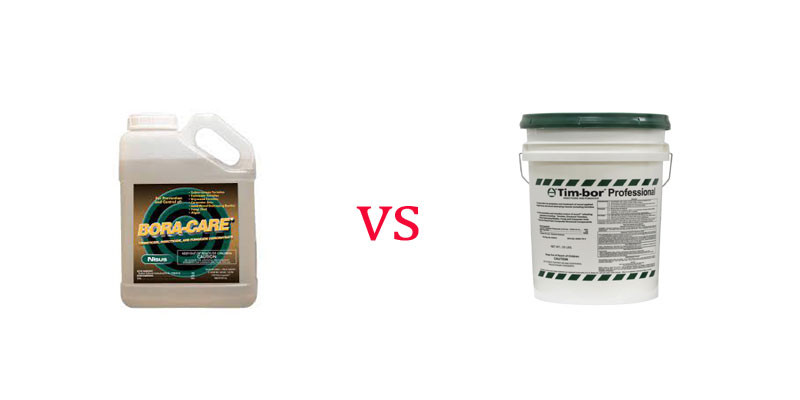Boracare and timbor are two wood treatment products that are used to protect against termites, beetles, and other pests. Boracare is a liquid borate solution that penetrates and eliminates pests inside the wood, while timbor is a water-soluble powder that is mixed with water to be sprayed or brushed onto the wood surface.
When it comes to preserving wood and ensuring its longevity, choosing the right treatment is essential. Boracare and timbor are two of the most popular wood treatment products used to protect against wood-destroying pests such as termites, beetles, and carpenter ants.
Boracare is a liquid borate solution that is sprayed into the wood, wherein the borate penetrates the wood and exterminates any pests that come in contact with it. On the other hand, timbor is a water-soluble powder that is mixed with water to be sprayed or brushed onto the wood surface. It provides similar protection to boracare with the added benefit of being able to treat wood that is already infested with pests. In this article, we will delve into the characteristics of each product, and which one would be a better fit for your specific needs.

Boracare Vs Timbor: Which Wood Treatment Is Better? Explained
Boracare vs timbor: which wood treatment is better? Explained.
Are you looking for an effective way to protect your wooden structures from damage caused by insects, fungi, or termites? If you are, you might have come across boracare and timbor treatments. Both treatments are used to protect wooden structures, but which one is better?
In this section, we will discuss the key differences between boracare and timbor.
Brief Explanation Of The Primary Use Of Boracare And Timbor Treatments
Both boracare and timbor are wood treatment solutions used to protect wooden structures from various pests. Boracare is used to control and eliminate wood-destroying organisms such as termites, carpenter ants, and wood-boring beetles. It is also effective against fungi that can cause damage to wood.
Timbor, on the other hand, is used to protect against wood-boring insects such as powder post beetles, old house borers, and carpenter ants.
Differences In Application And Target Pests Between The Two Treatments
Application:
- Boracare is applied by spraying, brushing, or foaming the solution onto the wood surface.
- Timbor is applied as a powder by dissolving it in water and then spraying or brushing it onto the wood surface.
Target pests:
- Boracare targets wood-destroying organisms such as termites, carpenter ants, and wood-boring beetles, as well as fungi that can cause damage to wood.
- Timbor targets wood-boring insects such as powder post beetles, old house borers, and carpenter ants.
Boracare and timbor are both effective wood treatment solutions used to protect wooden structures from various pests. Boracare is used to control and eliminate wood-destroying organisms such as termites, carpenter ants, and wood-boring beetles as well as fungi that can cause damage to wood.
Timbor, on the other hand, is used to protect against wood-boring insects such as powder post beetles, old house borers, and carpenter ants. Depending on your specific pest problem, you can choose the most suitable product to effectively protect your wooden structures.
Pros
When it comes to protecting your property from destructive insects and fungi, two popular treatment options are boracare and timbor. We’ll be focusing on the advantages of timbor over its competitor. Let’s dive in.
Details On The Effectiveness Of Timbor Against Insects And Fungi
- Timbor is a water-soluble pesticide and fungicide with a 98% active ingredient.
- It’s designed to penetrate wood to eliminate and prevent termites, beetles, carpenter ants, fungi, and other wood-damaging organisms.
- Timbor’s active ingredient, disodium octaborate tetrahydrate, disrupts the digestive system of insects and fungi when ingested, resulting in their death.
- Additionally, the pesticide residue left behind repels any further infestation.
Explanation Of How Timbor Can Be Applied To New And Existing Structures
Applying timbor is a simple process, and it can be done in both new and existing structures.
- For new construction, timbor should be applied to all exposed wood surfaces before insulation, drywall, or paneling is installed.
- Timbor can be applied as a spray or solution to all wood surfaces in a home, including walls, ceilings, and floors.
- It’s also effective in protecting outdoor wood structures, such as decks, fences, and sheds.
- Timbor can be mixed with water and applied using a pump sprayer or a brush.
Cost Comparison Between Timbor And Other Treatment Options
While the cost of treatment will depend on the severity of the infestation and the size of the property, timbor is an affordable option when compared to other treatments.
- Boracare, which is a competing option, requires a higher concentration of active ingredients to provide the same level of protection, making it a more expensive option.
- Timbor has been proven to be effective in treating wood-destroying organisms with a lower concentration of active ingredients, leading to a lower cost.
- When considering the cost of treating wood structures, it’s essential to weigh the cost of the treatment with the potential cost of repairs and replacements due to damage.
Timbor is an effective and affordable option for protecting your property from wood-damaging insects and fungi. Its easy application process and lower concentration of active ingredients make it a more convenient and cost-effective option than boracare and other treatments. Protect your property with timbor today.
Cons
Explanation Of Any Potential Drawbacks, Such As Its Impact On The Environment Or Difficulty Of Application
Boracare and timbor are popular wood preservatives used to protect wooden structures from damage caused by termites, carpenter ants, and other wood-destroying pests. However, these chemicals do come with some drawbacks that you should be aware of before proceeding with their application.
Here are some potential drawbacks of using boracare and timbor:
- Environmental impact: Boracare and timbor contain boric acid, a chemical that has low toxicity to humans but can be toxic to certain types of aquatic life if it enters waterways. Hence, it is essential to apply these chemicals responsibly to prevent them from leaching into the environment and causing harm.
- Application difficulty: Applying boracare and timbor can be a challenge, especially if you have no prior experience of handling these chemicals. Both products require some level of expertise in terms of dilution, mixing, and application to ensure their effectiveness. Also, optimal results can only be achieved when these chemicals are applied to bare wood surfaces.
Comparison To Other Treatment Options For Wood Preservation
While boracare and timbor are both effective wood preservatives, some alternative treatments can be just as effective. Here are some comparisons:
- Chemical vs. non-chemical: Boracare and timbor are chemical treatments that require careful handling to ensure their effectiveness. In contrast, non-chemical methods like heat treatment, cold treatment, and fumigation can be just as effective in eliminating wood pests and preserving wood structures. Ultimately, the method you choose depends on your preferences, budget, and the severity of the infestation.
- Coverage: Boracare and timbor are best suited for treating individual pieces of wood, such as furniture or small wooden structures. However, for larger structures such as log cabins, alternative treatments like fumigation or heat treatment may be more effective.
- Longevity: Boracare and timbor, when applied correctly, provide excellent protection against wood pests for many years. However, some alternative treatments like pressure-treated wood are known to last longer and offer more extended protection against insect damage and rot.
Boracare and timbor are both excellent options for wood preservation. However, they come with some potential drawbacks, including their impact on the environment and application difficulty. When considering your options, it’s essential to weigh the pros and cons carefully and choose a treatment method that best suits your needs.
Boracare Vs Timbor: Which Wood Treatment Is Better? Detailed Comparison
The protection and preservation of wood against pests and harmful elements is an essential task in maintaining the longevity and safety of wooden structures. Two popular wood preservatives used today are boracare and timbor. But which one is better? We’ll compare the effectiveness, cost differences and the potential impact on the environment of both treatments.
Comparison Of The Effectiveness Of Boracare And Timbor As Wood Treatments
- Both treatments are highly effective in protecting wood against pests like termites, beetles and fungi.
- Boracare offers a broader spectrum of protection as it also helps prevent structural decay.
- Timbor is more effective in preventing moisture-related damages as it works better in drier environments.
Comparison Of The Cost Differences Between The Two Treatments
- Boracare is more expensive than timbor, but it offers a more long-term solution.
- The cost of timbor will depend on the project’s size and affected area, making it harder to estimate the total cost.
Comparison Of The Potential Impact On The Environment Of Both Treatments
- Boracare has a lower environmental impact due to its water-based formula and low toxicity.
- Timbor contains more toxic chemicals and is not recommended for outdoor use or in areas with high humidity.
- Both treatments are safe when used properly, but using boracare is a more environmentally friendly choice.
When it comes to choosing between boracare and timbor, several factors like the environment, budget and the severity of the infestation must be considered. If you’re unsure, it’s best to consult with a professional and qualified pest control company to determine the best solution tailored to your needs.
Frequently Asked Questions For Boracare Vs Timbor
What Is Boracare?
Boracare is a borate-based insecticide designed for termite and wood preservation treatment.
What Is Timbor?
Timbor is a wood preservative insecticide that contains an active ingredient sodium borate.
What’S The Difference Between Boracare And Timbor?
Boracare is designed to effectively treat and protect wood against termites and beetles. Timbor, on the other hand, is specifically formulated for the prevention of wood decay fungi.
How Do I Apply Boracare And Timbor?
Both boracare and timbor should be applied to unfinished wood surfaces as a spray or brush application.
Are Boracare And Timbor Safe For Humans And Pets?
Boracare and timbor are generally safe for humans and pets when applied according to instructions. However, it’s essential to wear personal protective equipment during application.
Conclusion
Based on the comparison between boracare and timbor, it’s evident that both wood preservatives come with exceptional features that make them effective in protecting wood from insects and fungi. Boracare is ideal for protecting wood against termites, beetles and carpenter ants; while timbor is the best option for treating wood against rot and decay fungi.
Both products offer innovative and eco-friendly solutions that are safe for humans and pets. It’s vital to consider the properties of the wood you are treating and the type of infestation you’re dealing with before deciding which wood preservative to use.
The usage and application should be precise to avoid wastage of the product. Always obtain the necessary protective gear and instructions before application to prevent any contact with the skin or inhaling fumes. Choose wisely and protect your valuable wooden items with these effective products, which will ultimately save you time and money in the long run.





